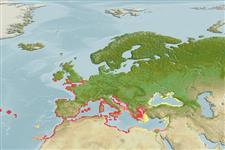Common names from other countries
>
Blenniiformes (Blennies) >
Blenniidae (Combtooth blennies) > Salariinae
Etymology: Coryphoblennius: Greek, koryphe = summit + Greek, belnnios = mucus (Ref. 45335).
More on author: Linnaeus.
Environment: milieu / climate zone / depth range / distribution range
Ökologie
seewasser demersal. Subtropical; 52°N - 20°N, 19°W - 42°E
Eastern Atlantic: along the coasts of western England and the British Channel, Spain, Portugal, France, Morocco, Madeira , Canary Islands; Mediterranean Sea, Sea of Marmara, and the Black Sea.
Size / Gewicht / Alter
Maturity: Lm ? range ? - ? cm
Max length : 7.6 cm SL Männchen/unbestimmt; (Ref. 5298)
Facultative air-breathing (Ref. 126274); Intertidal (Ref. 31184), found on the wave-battered rocky shores (Ref. 5298). May remain out of water under rocks and seaweeds (Ref. 31184). Omnivorous; feed mainly on copepods and ostracods as juveniles and shift to diet of algae as adults (Ref. 94105). Breathe air when out of water (Ref. 31184). Juveniles in small tide pools (Ref. 41018). Oviparous. Eggs are demersal and adhesive (Ref. 205), and are attached to the substrate via a filamentous, adhesive pad or pedestal (Ref. 94114). Larvae are planktonic, often found in shallow, coastal waters (Ref. 94114). Territories protected by males include depressions, crevices or piddock holes (Ref. 5981).
Life cycle and mating behavior
Geschlechtsreife | Fortpflanzung | Ablaichen | Eier | Fecundity | Larven
Distinct pairing (Ref. 205). During mating, the male fans the nest as if cleaning and ventilating the area. Males release sperm during periodic quivers to fertilize eggs in the nest much like other blennies (Ref. 55747). Males guard the egg-masses of various females (Ref. 5981).
Bath, H., 1990. Blenniidae. p. 905-915. In J.C. Quero, J.C. Hureau, C. Karrer, A. Post and L. Saldanha (eds.) Check-list of the fishes of the eastern tropical Atlantic (CLOFETA). JNICT, Lisbon; SEI, Paris; and UNESCO, Paris. Vol. 2. (Ref. 5298)
IUCN Rote Liste Status (Ref. 130435)
CITES (Ref. 128078)
Not Evaluated
Bedrohung für Menschen
Harmless
Nutzung durch Menschen
Fischereien: nicht kommerziell
Mehr Information
ReferenzenAquakulturAquakultur ProfilZuchtlinienGenetikElectrophoresesVererbbarkeitKrankheitenVerarbeitungMass conversion
PartnerBilderStamps, Coins Misc.LauteCiguateraGeschwindigkeitSchwimmstilKiemenoberflächeOtolithsGehirngrößeSehfähigkeit
Tools
Zusatzinformationen
Download XML
Internet Quellen
Estimates based on models
Preferred temperature (Ref.
115969): 12.5 - 20.8, mean 18.6 (based on 504 cells).
Phylogenetic diversity index (Ref.
82804): PD
50 = 1.0000 [Uniqueness, from 0.5 = low to 2.0 = high].
Bayesian length-weight: a=0.00741 (0.00335 - 0.01640), b=3.02 (2.83 - 3.21), in cm Total Length, based on LWR estimates for this (Sub)family-body shape (Ref.
93245).
Trophic level (Ref.
69278): 2.3 ±0.0 se; based on diet studies.
Widerstandsfähigkeit (Ref.
120179): hoch, Verdopplung der Population dauert weniger als 15 Monate. (Preliminary K or Fecundity.).
Fishing Vulnerability (Ref.
59153): Low vulnerability (10 of 100).
